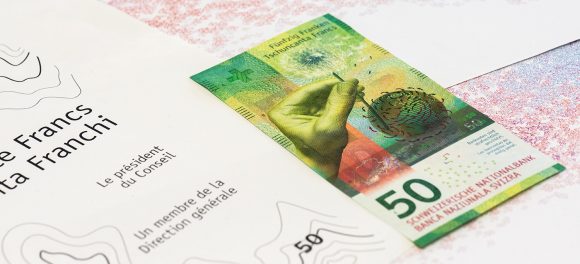We’re here for you
Arrange an appointment for a non-binding consultation or if you have any questions, just give us a call.

![]()
header.search.error
Cash
The new 50-franc note, which goes into circulation on April 12, is a world first. Seven key questions and answers.

1. What message is the 50-franc note aiming to convey to us?
The new series of Swiss banknotes shows the many facets of Switzerland. The 50-franc note focuses on the wealth of experiences Switzerland has to offer, symbolized by the movement of the wind, the wind-borne seeds of a dandelion, the system of wind currents flowing around the globe and a paraglider carried by the wind in the mountains.
2. What will the design of the other new banknotes be like?
All the new banknotes will have one thing in common: none of them will depict well-known personalities. Instead, they will show Switzerland as a creative, humanitarian and scientific country. Each banknote will feature four motifs: a hand, a globe, a location and an object. The new 50-franc note shows a hand holding a dandelion, North and South America and the Pacific Ocean on the globe and a mountain (a location) and a paraglider (an object), which symbolizes the element of wind. A special raised printing method makes various elements such as the number 50 easy to feel.
3. The previous series of Swiss banknotes was safe, so why do we need a new one?
Even though today’s notes are considered forgery-proof, the probability of a successful forgery increases year by year. The reason for this is the rapid pace of technological change and the new options it offers. The National Bank’s goal, therefore, is to be at the cutting edge of banknote technology.
4. Why do we need cash if we can already pay by mobile phone?
Cash remains a popular payment method. In fact, banknote circulation has increased in Switzerland in recent years. In 2007, banknotes with a nominal value of 40 billion francs were in circulation. This figure had risen to over 65 billion by 2015.
5. What makes the new banknote so secure?
The combination of complex printing methods, innovative paper and a multitude of new security features. Tilting the 50-franc note in certain directions causes a golden arc to move across the globe or the globe’s color to change, for example. A Swiss cross becomes visible only if you view the note from a specific angle. And with a magnifying glass, you can make out the names of all Swiss peaks higher than 4,000 meters.
6. Why is the paper so innovative?
Banknotes must be strong, durable and secure. Until now, Swiss notes have been made of cotton paper. For the new series, a three-layer substrate has been developed, consisting of two outer cotton paper layers and a polymer core to strengthen it. Parts of the layers are cut out – these are known as “windows” and form part of the security concept.
7. Why are the basic colors staying the same?
Banknotes must be easy to distinguish. That is why the National Bank is continuing to use clear colors from the full color palette. To prevent confusion, notes with similar numbers on them are given colors that are far apart on the color spectrum. That’s why the 10-franc note is yellow and the 100-franc note blue.
8. What are the hidden security features?
Three features can only be viewed with special aids. Under ultraviolet light, flecks worked into the paper glow like colorful fireflies and the globe shines bright green. If you examine the note with an infrared camera, a number of design elements disappear and others such as the hand and the globe become visible in monochrome.
9. How much does it cost to produce a banknote?
Around 40 centimes. That’s around 10 centimes more per banknote than the previous series.
10. Is it true that the thousand Swiss franc note is the most valuable note in the world?
Yes and no. The most valuable banknote that can still be used for payment is the 10,000 Singapore-dollar note, which is worth around 7,000 francs. However, in 2014, Singapore announced that it would gradually withdraw the note from circulation, due to its popularity as a payment method in criminal circles. The Brunei dollar, which is pegged to the Singapore dollar, also features a 10,000 note. So the Swiss 1000-franc note is the most valuable banknote in the world that is still being issued by a central bank.
Will the old notes be phased out?
The 20-franc note will appear next spring, followed by the other notes once every half year or year thereafter. The last note – the 100-franc note – will go into circulation in 2019. After that, notes from the previous series will be recalled, but the National Bank is expected to continue exchanging them until around 2039.
Arrange an appointment for a non-binding consultation or if you have any questions, just give us a call.
Disclaimer